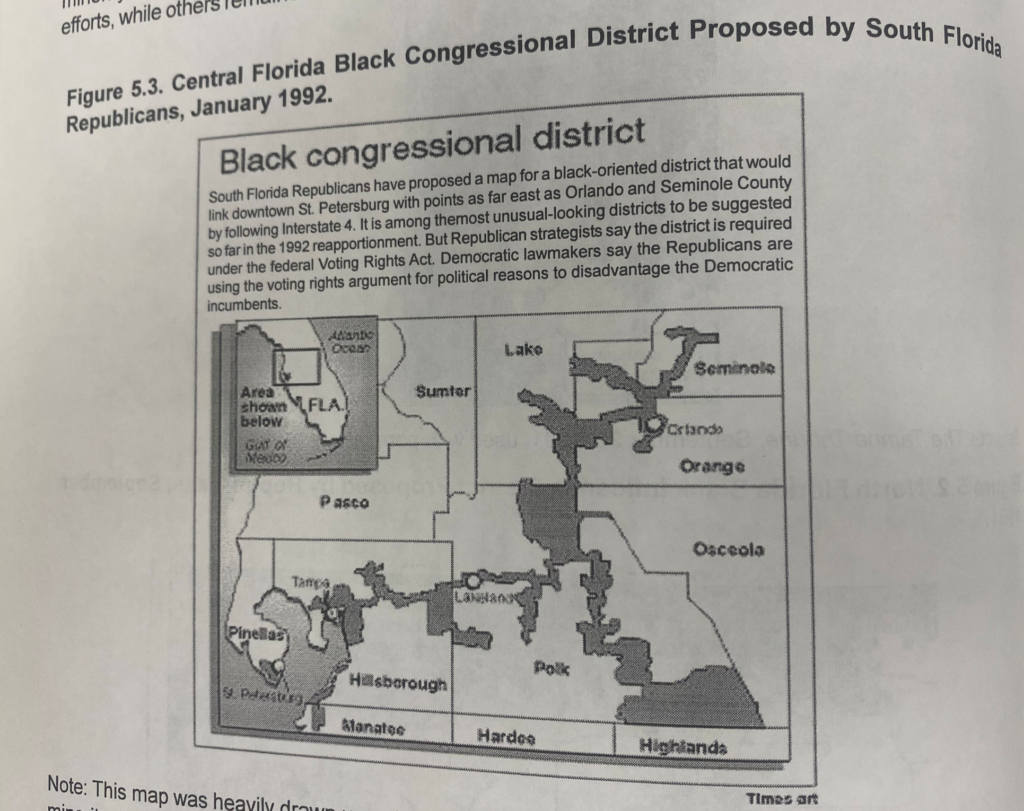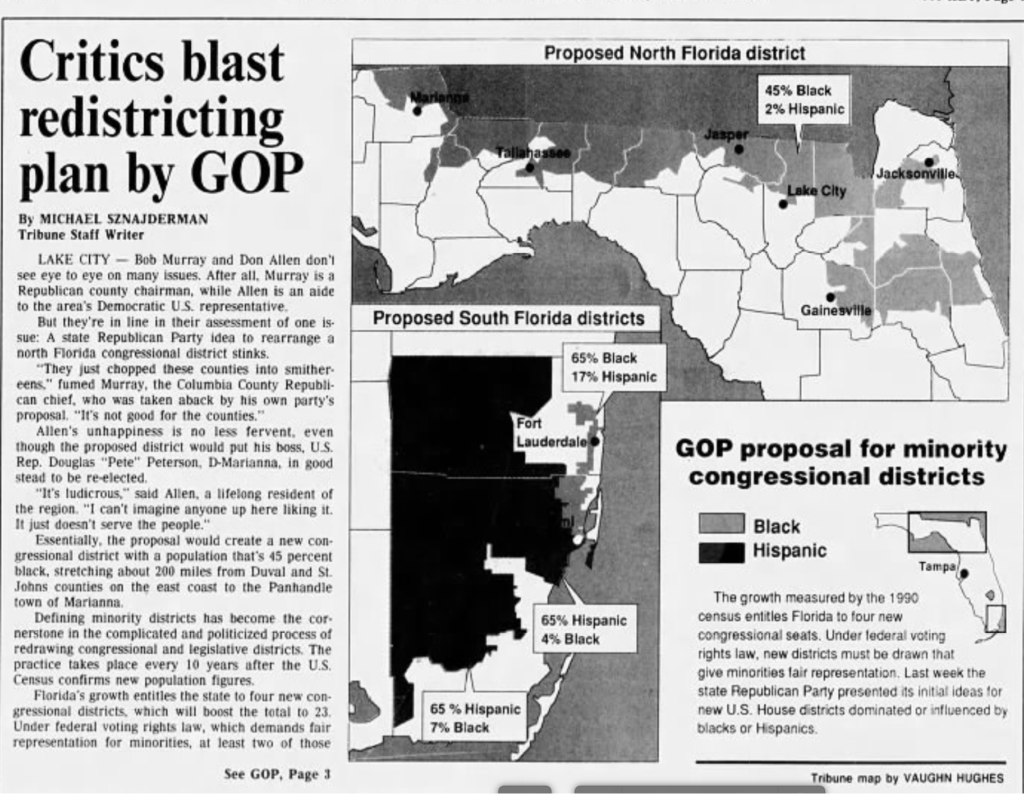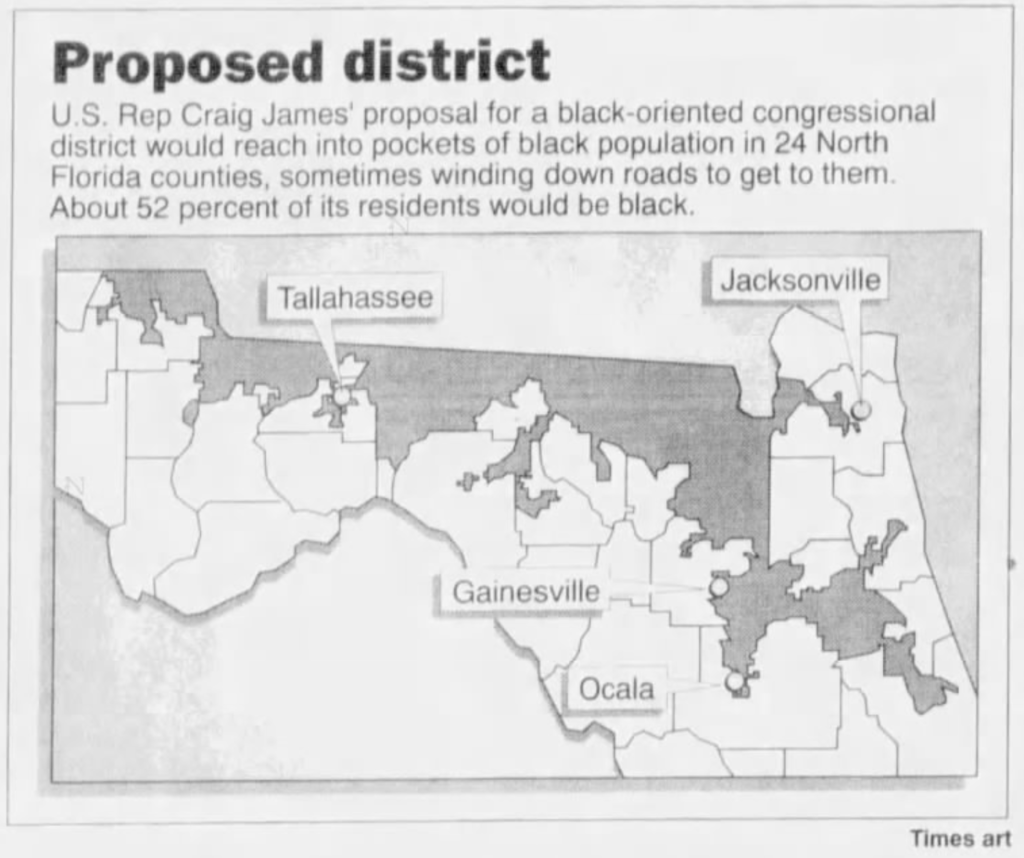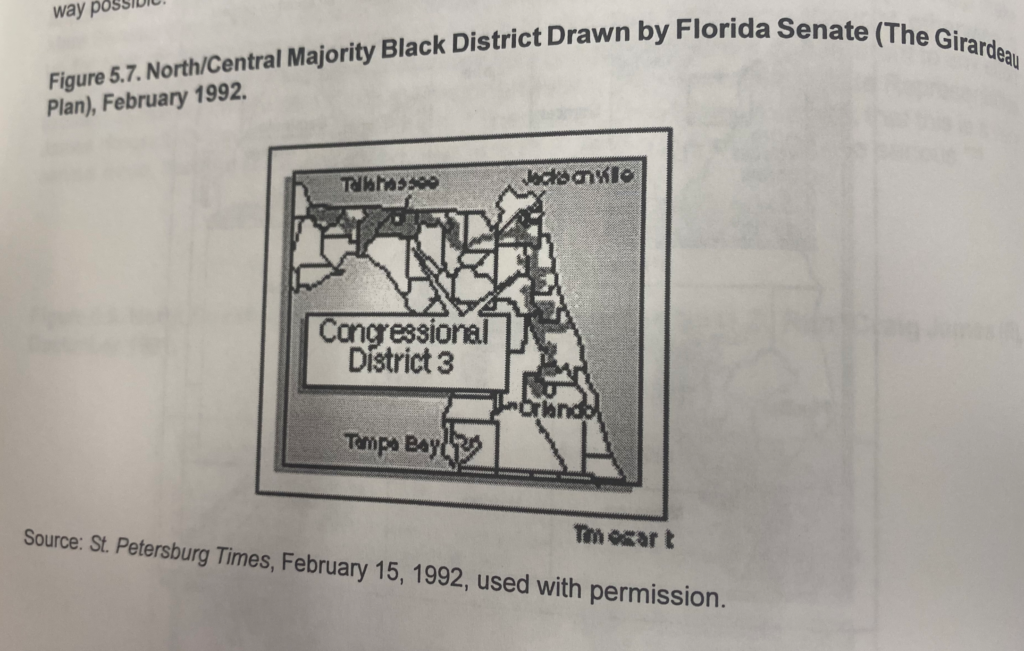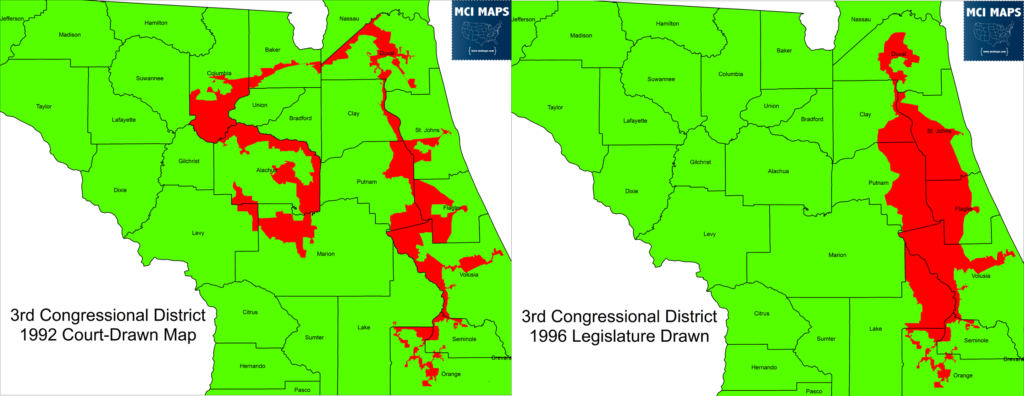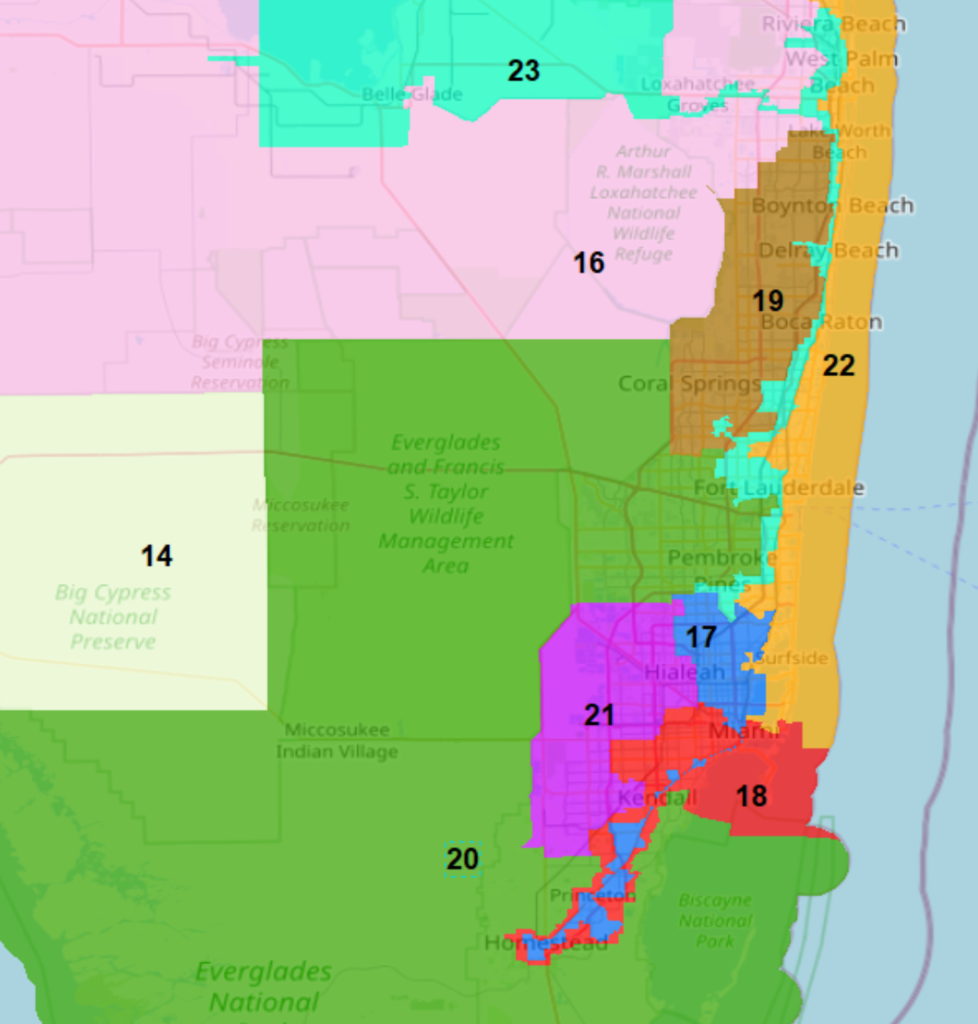Last week, I looked at the 1992 redistricting process for Florida’s State House and State Senate districts. I highly recommend you give that a read before following up with the article’s focus on the Congressional apportionment. Both sets of redistricting came under the same heated atmosphere: which saw the Democrat-controlled legislature try to cling to power while also implementing lines that adhered to the newly-amended Voting Rights Act.
Political Background
The Congressional redistricting process in Florida saw all the same tensions regarding race and party that the legislative redistricting process witnessed. Florida, thanks to growing over 30% since 1980, was entitled to FOUR new Congressional districts. The 1982 map saw no African-American districts drawn, and only one Hispanic district created. With the 1982 Voting Rights Act giving minority voters a much stronger legal position to file complaints from, and a DOJ threatening to file suit to ensure minority districts, it was widely expected Florida’s legislative map would see some minority seats. The major question was, how many?
African-Americans
The narrative about the 1990s redistricting process paints a story of African-Americans uniting with Republicans to push for more minority districts. This is an oversimplification of the story. What is indisputable is that African-Americans were demanding greater voices and a share of the districts. In the 1980s, some African-American districts in the legislature had been created, but none on the Congressional map. The anger in the community was understandable. As Miami State Rep Darryl Reaves said
“For 40 years blacks have been the party backbone. now we’ve come to collect, but all we get is ‘thanks but no thanks.’ its time to cut the umbilical cord and learn to feed for ourselves.”
Democrats had controlled the Congressional delegation until 1989. This came as the party was slowly loosing its grip on the state; with Republicans making gains through the 1980s. The natural inclination of the party would have been to use African-American voters to pad majorities in districts. This was directly in conflict with the desire of many to create minority districts.
Many African-American lawmakers were aware of the risk of packing black voters so much that it aided Republicans in capturing seats. However, many lawmakers wanted more opportunities. Some of the African-American lawmakers, notably Corrine Brown, were very aggressive and sought maximized plans. Meanwhile, organizations like the NAACP, while calling for at least 2 majority-black congressional districts, warned about overextending and creating a GOP-aligned map.
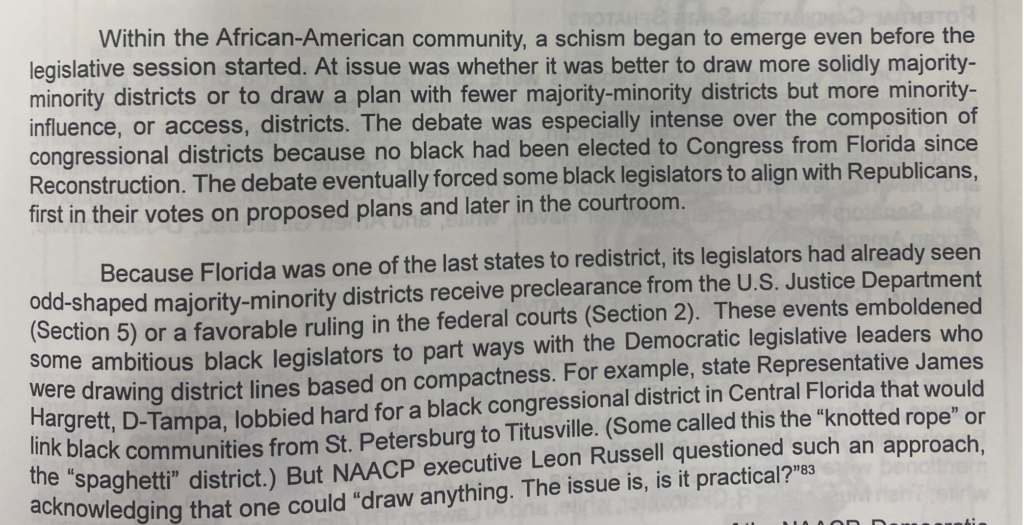

What African-Americans were united on was an opposition to the white Democratic leaderships desire to only continue on with “access seats.”
Republican Hispanics
The 1980s continued an explosion of the Hispanic population in Miami-Dade county. Cuban-Americans had been leaving the island for decades, but the 1980 refugee crisis saw hundreds of thousands settle over the next decade. The 1989 special election for FL-18 saw the election of the first Cuban Congressperson; Ileana Ros-Lehtinen. The 18th, at the time, was a modestly Hispanic district that also included large black and Jewish populations. The special election for the 18th saw a nasty and racially-divisive election. The special election, coupled with the growing Hispanic population, led Hispanic Republicans to call for super-charged districts that were super-majority Hispanic. Republican State Senator Mario Diaz-Balart said that both districts should be at least 60% Hispanic. Part of the push for super-majority districts was also to factor in the large number of non-citizen Hispanics in the county. Hispanic Republicans in Miami-Dade called for two districts; which the census data said they were entitled to.
The Congressional Delegation
As Florida lawmakers grappled with the major population shifts and growing calls for minority districts, the Congressional delegations sweated on the sidelines. Though the sidelines is probably the wrong phrase, as Congresspeople were heavily involved in lobbying on different districts. This lobbying, however, would often come into conflict with the desires of lawmakers to make runs for higher office. It was no secret that many members of the legislature had their eyes on DC.
Congressional Redistricting
While the legislature had managed to pass a legislative plan, it would not be so lucky with a Congressional map. The legislative session, and special sessions that followed, could not lead to a workable map that both sides would support. Republicans released their own proposal as early as September of 2021. It called for four African-American districts and two Hispanic super-majority districts. Initial Democratic plans included two black seats (one access in North Florida and one majority in Southeast Florida) and one solidly Hispanic seat (with a second at 54% Hispanic share). This difference pretty well summarizes the dynamic for the 1990s Congressional redistricting process in Florida. One party aimed to pack minority voters to aid themselves. The other party aimed to crack minority voters to aid themselves. Minority lawmakers, in the meantime, divided on plans depending on the circumstances. Several praised the GOP maps – others saw them as a cynical exercise.
Both chambers agreed on multiple regions, but had strong disagreements in others. In addition, Hispanic and African-American lawmakers had plenty to dislike about different proposals.
Amendments were offered from multiple parties, aiming to create new minority districts.
The black caucus would produce their own map; which created four African-American districts; similar to the GOP plan. Many in the caucus were still divided on the best plan of action. Chairman Willie Logan made it clear to Democratic leaders, who were pressuring the caucus to accept fewer districts, that they could not count on the black caucus for votes if they felt their issues were not being heard.
“All bets are off. No more blind faith.
Black Caucus Chair Willie Logan to the Democratic leadership
Democratic leaders in both chambers aimed to lock in a Congressional majority for the delegation. The first proposal out of the state Senate turned the 10 GOP v 9 DEM delegation into a likely 9 GOP v 14 DEM delegation. However, doing this and adhering to the VRA and the demands of African-American lawmakers was impossible.
Chiles Gets Involved – House and Senate Passes Maps
Members of Congress furiously lobbied the lawmakers; but sometimes these efforts didn’t help. Eventually, Democratic Congressmen Pete Peterson (Marianna) and Jim Bacchus (Orlando) lobbied Governor Lawton Chiles directly. Chiles had the power to veto a Congressional plan (but not a legislative plan). The lawmakers appealed to Chiles to reject a map that had sprawled out districts that aimed to grab every African-American voter within hundreds of miles. While the issue of compact vs minority districts is a complicated issue; it should be made clear both of these members were lobbying from a place of personal concern for their re-elections.
By January, the Senate had a compromise plan slowly taking form: known as the Girardeau Plan; drawn by Jacksonville’s line black Senator, Arnett Girardeau. The plan created two African-American districts and two Hispanic districts. However, the 2nd Hispanic seat was only 54% Hispanic; and many believed it could therefor perform as a white district. Chiles made his and the concerns of the Congressmen known, which delayed a vote on the plan for a few weeks. Eventually, Senate President Gwen Margolis announced that the plan would be put before a vote, along with several other proposals from the black caucus, Hispanic caucus, and Republicans. In the end, only the Girardeau Plan could get a majority; a party line vote of 22-18.
The State House passed its own version in February of 1992. Their plan created two majority-black districts, a black-access district, and two majority-Hispanic seats. Similar to the Senate, votes were held on multiple other plans; including those from the black caucus, Hispanic caucus, and GOP. The leadership compromise plan was the only one to pass the chamber. Most of the black caucus backed the leadership plan; but they also hoped to score changes in conference with the Senate. In addition, Hispanic and African-American lawmakers demanded roll call votes be held on all maps; pushing back on Speaker T.K. Wetherell’s efforts to push voice votes on most plans.
House and Senate Disagreements
Despite both chambers being held by Democrats, the House and Senate remained deadlocked on redistricting. The state senate appeared to be much more beholden to state Senators who wanted to run for Congress. For example, the Senate’s version of a majority-black district in North Florida stretched from Tallahassee to Jacksonville, then down to Orlando. The district was drawn that way to ensure another district for Karen Thurman was available in the middle. In addition, Senate President Gwen Margolis was intending to run for Congress. Margolis, who hailed from rapidly-diversifying Miami-Dade, needed a more anglo-heavy seat to run in – which conflicted directly with the desire of Hispanics to get two solidly Hispanic seats in the region.
The ambitions of both Margolis and Thurman made any compromise with the house impossible. The house was unwilling to support the Senate’s plan in Southeast Florida. The Senate plan had its 21’st district drawn at 54% Hispanic, but due to turnout and citizenship dynamics, would likely seeing more white votes cast. The house plan set up two solidly Hispanic districts instead.
On March 12th, the house rejected the Senate’s congressional plan. The next day the regular session came to an end. A special sessions would have to be called.
Short and Tense Special Session
The special session on Congressional redistricting began on March 23rd. The legislature was under tremendous pressure to complete their work before the courts got involved. Speaker Wetherell opined that April 3rd was likely the “drop-dead” date; where courts would likely declare the legislature at an impasse.
The tight deadline didn’t help either side make a breakthrough. Minority members demanded their rightful number of districts; while incumbent Congressmen kept up their lobbying pressure. Meanwhile, the House and Senate could still not come to an agreement between their leaders; with the Senate’s proposals for Southeast Florida being flat-out rejected by the house. Democratic unity (to whatever extent it existed) completely broke down.
In the house, a “rebel map” backed by Republicans and a group of white and black Democrats came within two votes of passing; 56-59. Four African-American lawmakers backed the proposal: Jim Hargrett, Darryl Reaves, Corrine Brown, and Al Lawson. Four other African-American lawmakers rejected it: Betty Holzendorf, Alzo Reddick, Bill Clark, Cynthia Chestnut. This plan created four black-oriented districts. Eventually the house was able to pass its leadership-desired map, which was similar to the pre-special map.
While the house managed to pass a proposal, the Senate couldn’t even agree on a map itself. Two Democrats, Larry Plummer and Vince Bruner, voted with the GOP to kill the Senate leadership plan. Bruner would switch to the GOP just a few months later. Plummer said he resented Margolis’ efforts to draw a seat for herself and he didn’t like how his area was being drawn.
The Senate adjourned on March 26th, at a clear impass. The next day, March 27, a federal 3-judge panel, declared the legislature was at an impasse. Chiles pleaded for lawmakers to give it one more go. However, there was no hope for a legislature-passed plan. All efforts came to a formal end on March 30th.
Court Takes Over
With the legislature at an impasse, a three-judge panel took over the process. They brought in a special master, Judge Clyde Atkins, to work on getting a final map. The deadline from the court for a final map was May 29th. David Gelfand, a Tulane University professor, was hired as the expert witness. Atkins and Gelfand heard hours of testimony and looked at 12 plans submitted by different groups and people. In the end, Gelfand would string together a map that took elements from multiple parties. The plan created three African-Americans districts (two majority, one with over 45% BVAP) and two solidly Hispanic districts in South Florida. The map gave no consideration to incumbent residencies.
[My Goal is] “effective minority representation and the least possible political gerrymandering”
Gelfand on his rational in drawing a map
The minority district data was as follows. Full data report here.
- FL-3: 50.1% Black VAP
- FL-17: 51.3% Black VAP
- FL-23: 44.4% Black VAP
- FL-18: 67.5% Hispanic VAP
- FL-21: 70.6% Hispanic VAP
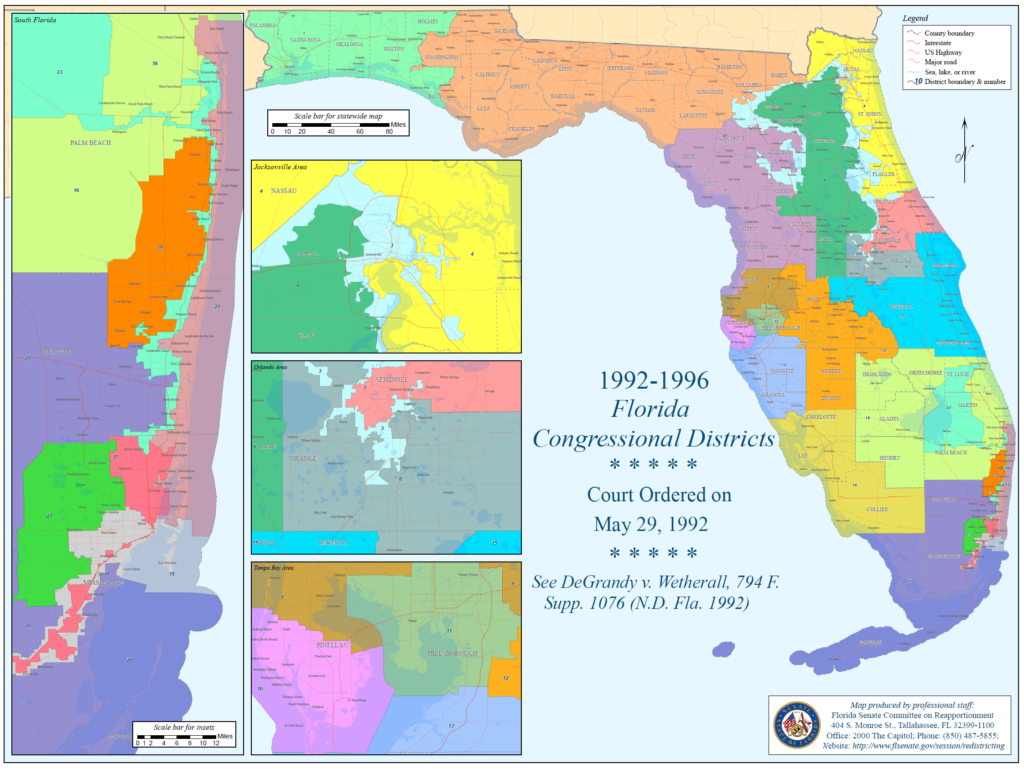
The plan went into effect for 1992. It elected three African-American congress people: Alcee Hastings, Carrie Meek, and Corrine Brown. It also elected two Hispanic Republican, Ileana Ros-Lehtinen and Lincoln Diaz-Balart. The election resulted in a 12 GOP, 11 DEM delegation – similar to the 10-9 split from the 1990 elections. Brown defeated Senator Arnett Girardeau in the Democratic primary for the FL-3. Karen Thurmond did win her Congressional seat; but Gwen Margolis lost her bid for Congress.
Democrats would lose two more seats in the 1994 election; taking the delegation to 14-9. Democratic opponents of the plan point to this as proof the maps doomed Democrats. However, that same day, Governor Lawton Chiles narrowly won re-election against Jeb Bush. Chiles took 11 districts, while Bush took 12. Democrats lost in seats Chiles had won.
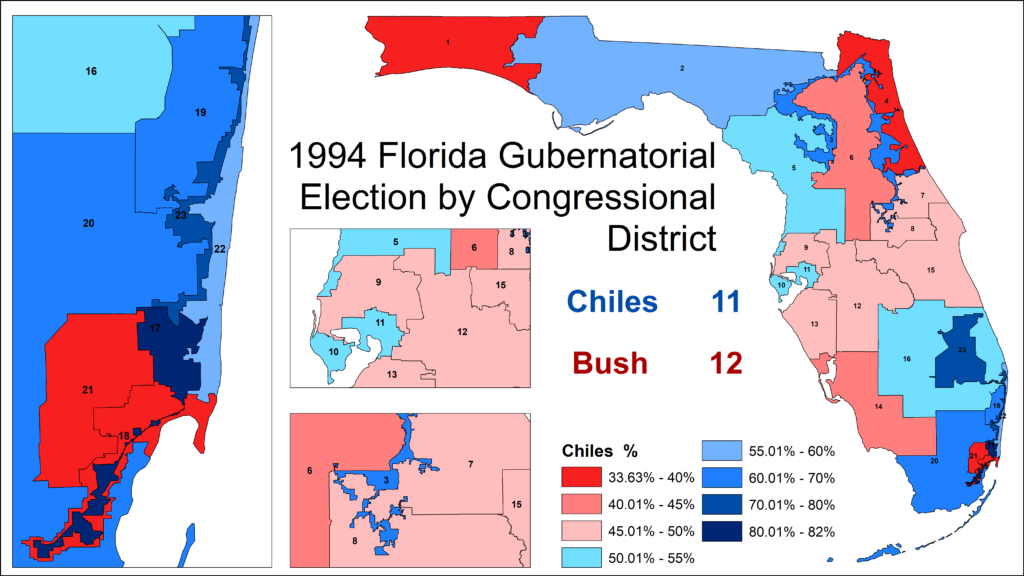
In addition, one of their losses was in the FL-01, which had nothing to do with odd lines and everything to do with changing partisan alliances. As discussed in last-weeks article on the state legislative maps, the Republicans were on the rise in Florida in the 1990s. Republicans would win the Governorship in 1998 and take take legislative control.
1990s Redistricting and Court Cases
This districts remained in place for the 1992 and 1994 elections, but would eventually be redrawn. The Supreme Court would issue two major rulings regarding race and redistricting. In 1993, the court issue its Shaw v Reno decision; striking down a district in North Carolina (map). In the Shaw case, Justice O’Conner wrote that such race-based districts are subject to strict scrutiny, meaning they must satisfy three conditions: a compelling government interest, narrowly tailored to achieve the goal, and use the least restrictive means to achieve the goal.
The court also struck down a minority district in Georgia (map) in Miller v Johnson in 1995. In the decision, Justice Kennedy wrote….
“a reapportionment plan may be so highly irregular and bizarre in shape that it rationally cannot be understood as anything other than an effort to segregate voters based on race”
Miller v Johnson ruling
District 3 Struck down
With these cases, voters who disliked district 3, Corrine Brown’s sprawling North Florida district, had hope for a legal challenge. This case, known as Johnson v Smith, began in 1994 and began working through the courts. In late 1994, the court rejected the challenge, however, due to elections already underway for the midterm. However, in November 1995 in Johnson v. Mortham, a 3-judge declared District 3 as a racial gerrymander not protected by the VRA. The court cited the far-flung communities connected by narrow lines and there not being enough evidence of racially polarized voting in the region. The court gave defendants a chance to provide evidence to allow the district to survive strict scrutiny. However, in April of 1996, the court officially struck down the district and ordered the legislature to do a redraw. The legislature was given till May 22nd.
Legislative Fight
By this point, the legislature was divided; with Democrats controlling the house and Republicans controlling the Senate. There was divided within the democratic caucus itself over how to draw a minority influence seat. On top of this, Governor Chiles still held a veto pen.
The house set up a redistricting committee led by African-American lawmaker Willie Logan. The major debate was whether a district should stretch from Jacksonville to Orlando, or from Jacksonville to Tallahassee. In the end, the legislature decided on a North-South alignment.
Interactive Version of New Map
The new district was more compact and less African-American. It went from over 50% black VAP to 42.3%. However, the district remained heavily Democratic and always in the hands of Corrine Brown.
Failed Lawsuit in Southeast Florida
In 1998, a lawsuit was filed against districts 17, 18, and 23. This was a challenge against two African-American and one Hispanic districts; demanding they be drawn more compact.
In 1999, a settlement was proposed to change the lines; making them more compact and lowering the minority populations. However, opposition from Congressman Alcee Hastings and Congresswoman Carrie Meek killed the political will of the GOP-run legislature and then-Governor Jeb Bush. When the case got to trial in October of 1999, it was ruled the trial was too late and that new census data and new districts were not far away.
Conclusion
The redistricting process in the 1990s was chaotic in many states. With a decade of court cases to follow, many maps were redrawn. However, while the chaos gets the bad press, the results speak for themselves. Florida’s delegation had African-American members for the first time since Reconstruction. Hispanic power in Miami-Dade was finally being realized.
Nationwide the story was the same. The jump from 1990 to 1992 saw a net increase of 12 African-American congresspeople.

Many democratic operatives decried how poorly the redistricting process went for them. However, Florida was already trending to the right. In the end, only an extensive partisan gerrymander would have made Democratic control of the delegation possible. The 1982 VRA Amendments didn’t allow Democrats to do that – instead giving new voices and representation to groups that had long been denied it.


